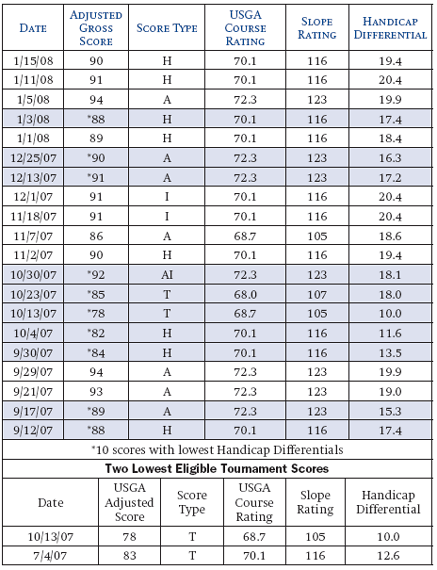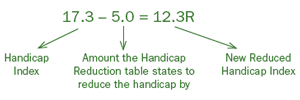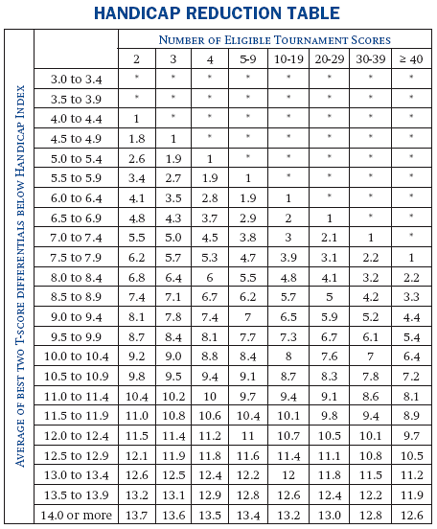Section 10 USGA
HANDICAP FORMULA
Definitions
Within each
section, all defined terms are in italics and are listed alphabetically
in Section 2 - Definitions.
Potential ability
is defined by the term Handicap
Index and is measured through a calculation using the player's best
scores. These best scores are determined by calculating the Handicap
Differential for each score. The Handicap
Index is calculated by taking 96 percent of the average of the best Handicap Differential(s), and applying Section 10-3 for players with
two or more eligible
tournament scores.
10-1. Calculation of Handicap Differentials
A Handicap
Differential is computed from four elements: adjusted
gross score, USGA
Course Rating, Slope Rating, and 113 (the Slope
Rating of a course of standard difficulty). To determine the Handicap
Differential, subtract the USGA
Course Rating from the adjusted
gross score; multiply the difference by 113; and divide the resulting
number by the Slope
Rating. Round the final number to the nearest tenth.
Handicap
Differential = (Adjusted
Gross Score - USGA
Course Rating) x 113 / Slope
Rating
![]() a. Plus Handicap Differential
a. Plus Handicap Differential
When the adjusted
gross score is higher than the USGA
Course Rating, the Handicap
Differential is a positive number. The following is an example for
determining a Handicap
Differential using an adjusted
gross score of 95 made on a course with a USGA
Course Rating of 71.5 and a Slope
Rating of 125:
|
95 - 71.5 = 23.5 |
|
|
Difference x
Standard Slope
Rating: |
23.5 x 113 =
2655.5 |
|
Result / Slope
Rating: |
2655.5 / 125 =
21.24 |
|
Handicap
Differential (rounded): |
21.2 |
![]() b. Minus Handicap Differential
b. Minus Handicap Differential
When the adjusted
gross score is lower than the USGA
Course Rating, the Handicap
Differential is a negative number. The following is an example for
determining a Handicap
Differential using an adjusted
gross score of 69 made on a course with a USGA
Course Rating of 71.5 and a Slope
Rating of 125:
|
69 - 71.5 = -2.5 |
|
|
Difference x
Standard Slope
Rating: |
-2.5 x 113 =
-282.5 |
|
Result / Slope
Rating: |
-282.5 / 125 =
-2.26 |
|
Handicap
Differential (rounded): |
-2.3 |
The Handicap
Index formula is based on the best Handicap Differential(s) in a player's scoring
record. If a player's scoring
record contains 20 scores, the best 10 Handicap
Differentials of the most recent 20 scores are used to calculate the Handicap
Index. As the number of scores in the scoring
record decreases, the percentage of scores used in a scoring
record decreases from the maximum of the best 50 percent. If the scoring
record contains 9 or 10 scores, only the best three scores (30 to 33
percent) in the scoring
record will be used. Thus, the accuracy of a player's Handicap
Index is directly proportional to the number of acceptable scores
posted. A Handicap
Index must not be issued to a player who has returned fewer than five
acceptable scores. The following procedures illustrate how an authorized golf association,golf club, and computation
services calculate a player's Handicap
Index.
The procedure for
calculating a Handicap
Index is as follows:
Step 1: Use the table below to determine the number of Handicap Differential(s) to use:
|
|
Step 2: Determine Handicap Differential(s);
Step 3: Average the Handicap Differential(s) being used;
Step 4: Multiply the average by .96*;
Step 5: Delete all numbers after the tenths' digit (truncate). Do not
round to the nearest tenth.
Example 1: Fewer than 20 scores (11 scores available).
|
Total of lowest 4 Handicap
Differentials: |
104.1 |
|
Average (104.1 / 4): |
26.025 |
|
Multiply average by .96: |
24.984 |
|
Delete all numbers after |
24.9 |
|
24.9 |
* Bonus for
Excellence is the incentive for players to improve their golf games that is
built into the USGA
Handicap System. It is the term used to describe the small percentage below
perfect equity that is used to calculate a Handicap
Index (96 percent). As a Handicap
Index improves (gets lower), the player has a slightly better chance
of placing high or winning
a handicap event.
Example 2: Twenty scores available. The
following is an example of a Handicap
Index calculation for a player with 20 scores.
|
Total of 10
lowest Handicap
Differentials: |
154.8 |
|
Average (154.8 /
10): |
15.48 |
|
Average
multiplied by .96: |
14.861 |
|
Delete all digits
after tenths: |
14.8 |
|
14.8 |
Step 6: Apply Section 10-3 for players with
two or more eligible
tournament scores.
|
|
10-3. Reduction of Handicap Index Based on Exceptional
Tournament Scores
Using the
definition of a tournament
score (see tournament
score and Decisions 10-3/1 through 10-3/6), the committee (preferably
the Handicap
Committee in consultation with the committee in charge of the
competition) must determine in advance whether a score is to be designated as a
tournament
score that is to be identified by the letter "T" when
posted (e.g., 82T). These scores are often referred to as "T-Scores"
as in Section 10-3c.
![]() a. Procedure
a. Procedure
The following
procedure must be used as an alternate calculation of a Handicap
Index for players with two or more eligible
tournament scores. A player's Handicap
Index may be reduced under this procedure when a player has a minimum
of two eligible
tournament score differentials that are at least 3.0 better than the player's Handicap
Index calculated under Section 10-2.
The Handicap
Committee or handicap computation service must apply the following steps
to determine if there is a reduction in Handicap
Index calculated under Section 10-2.
![]() b. Steps
b. Steps
Example: A player with a Handicap
Index of 17.3 has three eligible tournament
scores, an 82T, 83T and 85T. Two of these eligible tournament
scores, an 82T and 83T, produce the lowest tournament
score differentials. They were made on a course with a USGA
Course Rating of 70.6 and a Slope
Rating of 130.
Step 1: Calculate tournament
score differentials by subtracting the USGA
Course Rating from each eligible
tournament score; multiply the result by 113, and divide by the Slope
Rating for each course played. Select the two lowest eligible
tournament score differentials.
|
|
Step 2: Subtract the second lowest differential from the Handicap
Index under Section 10-2. Continue with the
next step if the result is 3.0 or greater.
|
|
Step 3: Average the two lowest tournament
score differentials.
|
|
2 best T-score
Differential average of
differentials 2 lowest T-scores
Step 4: Subtract that average from the player's Handicap
Index.
|
|
Step 5: Using the number (rounded to the nearest tenths place (7.0)
from step 4 and the total number of tournament
scores in the player's record (3), use the Handicap Reduction Table to
determine the amount the player's Handicap
Index is to be reduced.
Step 6: Subtract the table value from the player's Handicap
Index. The result of that subtraction will be the player's reduced Handicap
Index, provided that it is at least 1.0 less than the Handicap
Index based on the formula in Section 10-2. The reduced Handicap
Index is to be identified with the letter R when displayed in
handicap reports or on the computer screen, e.g., 12.3R.
|
|
|
|
Example:
Value from Handicap
Reduction Table 5.0
Handicap
Index -- Table Value: 17.3 - 5.0 = 12.3
Reduced Handicap
Index: 12.3R
![]() c. Counting Tournament Scores
c. Counting Tournament Scores
(i) T-Score Counter
-- The number of eligible
tournament scores will be counted on a revolving twelve-month basis. In order to
keep track of the counter, but not save every T-Score, a counter for each month
is needed. The T-Score counter will contain the sum of the latest twelve
monthly counters plus any T-Scores older than one year that are a part of the
twenty score history. The monthly counter will increase based on the date a
score is processed, not the date of the score.
(ii) Best T-Score
File -- Up to the best six eligible
tournament scores are saved in a "Best T-Score File," separate from the
player's handicap record of the latest 20 scores.
(iii) Adding
T-Scores -- When a new tournament
score is posted, it becomes part of the player's normal handicap
record as a score and Handicap
Differential. If the "Best T-Score File" has fewer than six eligible
tournament scores, the new T-Score is added to that file. If the file already has
six T-Scores, the new T-Score, if better than any T-Score in the file, is added
to the file and the worst T-Score in the file is deleted, regardless of the
date of the T-Score.
(iv) Discarding Old
T-Scores -- At each handicap revision, each
T-Score in the "Best T-Score File" is checked to see if the score is
older than one year and no longer part of the player's current twenty score
history. If so, the score is deleted from the file. Deleted T-Scores are
replaced by the best eligible tournament
score (if any) in the player's handicap record that are not already
in the "Best T-Score File."
![]() d. Duration and Variation of
Reduction
d. Duration and Variation of
Reduction
Handicap
Index reduction for exceptional tournament
scores is calculated at each handicap revision and may vary from
revision to revision based on a number of factors. These factors may include
the following:
• Additional tournament scores;
• Expiration of eligible tournament scores;
• Variation in 10-2 calculation;
• Fluctuation of 10-2 calculation in
relation to the two lowest T-Scores.
![]() e. Handicap Committee Review of
Reduction
e. Handicap Committee Review of
Reduction
The Handicap
Committee must review all reductions. As a result of review, the Handicap
Committee may:
• Continue to allow
the reduction to run its normal course, as described in Section 10-3d, or
• Further reduce
the Handicap Index. For example, the
committee may conclude that the player's performance continues to be better
than the potential ability indicated by the 10-3 reduction. In that case, the
committee replaces the reduced Handicap
Index with an even lower reduced Handicap Index, continuing to review the reduction
after each revision period (See Section 8-4e), or
• Override the reduction. For
example, the committee may cancel the reduction to a Handicap
Index for a player who has been injured and whose reduction was based
on early tournament
scores prior to the injury. In that case, the reduction is
inconsistent with the player's scoring record. The committee
replaces the reduced Handicap
Index with the Handicap
Index calculated under 10-2 and ceases
designating it with an R. The committee will have the option to continue to override after each
revision period for as long as at least two exceptional tournament
scores continue to trigger a 10-3 reduction. Once
the player's scoring
record contains fewer than two exceptional tournament scores, the committee must cease overriding
and rely on the normal calculation under 10-2.
• Adjust the amount
of the reduction. The Handicap
Committee may decide that the player's full 10-3 reduction does not
reflect their potential ability, but a reduction is still necessary. In this
case, the Handicap
Committee may modify the amount of the reduction and the player's Handicap
Index as calculated by Section 10-2. For example, if
the player's 10-3 calculation is a
10.0R, but the 10-2 calculation is
15.0, the Handicap
Committee could change the player's reduced value to a value of 12.5M.
This does not completely override the player's
reduction.
![]() f. Reporting Requirement
f. Reporting Requirement
Authorized
golf associations and handicap computation services must report any Handicap
Index reductions under this procedure (Section 10-3b) to the golf club. If computational
reports are provided to the authorized
golf association, the handicap computation service must also report any Handicap
Index reductions to the authorized
golf association. When a Handicap
Index is reduced under this section, it must be identified with the
letter R (e.g., 12.3R).
A player's Course
Handicap is determined by multiplying a Handicap
Index by the Slope
Rating of the course played and then dividing by 113. (See Section 3-3.) The resulting
figure is rounded off to the nearest whole number (.5 or more is rounded
upward).
10-5. Nine-Hole Handicaps-Handicap Index (N)
![]() a. Nine-Hole Handicap Use and
Identification
a. Nine-Hole Handicap Use and
Identification
A nine-hole
handicap is a Handicap
Index (N) if the club follows the USGA
Handicap System. A nine-hole handicap, or Handicap
Index (N), may be used in inter-club play against other players with
nine-hole handicaps. If a competition requires a Handicap Index, a Handicap
Index (N) may be doubled for 18-hole play.
A player with both
a Handicap
Index and a Handicap
Index (N) should use the Handicap
Index (N) in inter-club nine-hole competition and the Handicap
Index in 18-hole competition.
A player with only
a Handicap
Index playing in a nine-hole competition halves the Handicap
Index and rounds the decimal upward to the nearest tenth, then
converts it to a Course
Handicap using the nine-hole Slope
Rating from the Course
Handicap Table for the tees being played.
![]() b. Method of Computation
b. Method of Computation
Golf
clubs compute a Handicap
Index (N) by applying nine-hole adjusted
gross scores to the USGA
Course Rating and Slope
Rating of the nine holes played to determine Handicap
Differentials.
Note: Players with a Handicap
Index (N) who play an 18-hole round, must post two nine-hole scores
to their scoring
record (N).
Example: For a nine-hole adjusted
gross score of 45 with a nine-hole USGA
Course Rating of 36.2 and a Slope
Rating of 121, the nine-hole Handicap
Differential is (45 - 36.2) x 113 / 121 = 8.2. If the average of the best
ten nine-hole Handicap
Differentials is 8.9, then the Handicap
Index (N) is 8.9 x .96 = 8.5. It is posted as "8.5N."
![]() c. Nine-hole Equitable Stroke Control
c. Nine-hole Equitable Stroke Control
See definition of Equitable Stroke Control.
|
|
Example: A player with a nine-hole Course
Handicap of 12 must adjust to a maximum score of 8 for any hole,
regardless of par.
![]() d. Maximum Nine-Hole Handicap
d. Maximum Nine-Hole Handicap
The maximum Handicap
Index (N) is 18.2 for men and 20.2 for women.
Note: A maximum Handicap
Index will convert to a Course
Handicap that exceeds these numbers on golf courses with a Slope
Rating greater than 113.
A player may have a
local
handicap above these limits, but it must be identified as a local
handicap by the letters "NL" following the number on a
handicap card or report (e.g., 24.5NL). (See handicap
type.) When such a local
handicap is used for inter-club play, the USGA recommends that it be
reduced to the maximum Handicap
Index (N) specified above.








